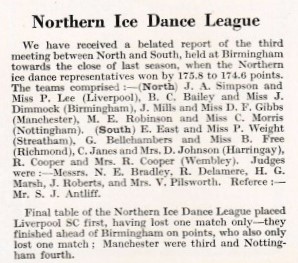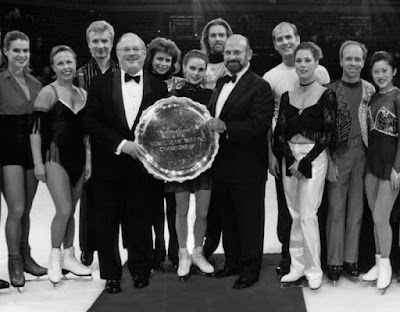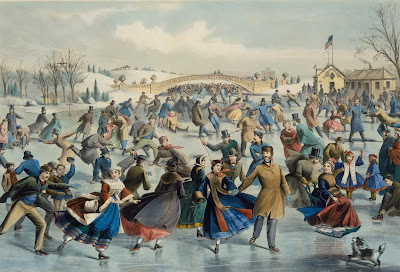The daughter of manufacturer Robert Mckenzie Bertram and Louisa Hope Hodgins, Frances Louise Bertram was born May 30, 1907. She was raised in prosperous circumstances on Spadina Road in Toronto with two live-in servants and two brothers, Robert and William. She was the middle child.
Louise made her singles debut at the Canadian Championships the following year, competing in 'novice ladies singles' against Cecil Smith's sister Maude, which essentially would have been a junior event as there was no junior category. Stewart finished second in the senior men's event behind Montgomery Wilson and won the fours event with partner Veronica, Margaret Henry and John Machado.
The following year at the Canadian Championships, Louise and Stewart finished right behind Constance and Montgomery Wilson in the pairs event and second in fours with Margaret Henry and Hupert Sprott. After that event, they debuted a tango-themed program set to a piece from the film "Flying Down To Rio" called "Orchids In The Moonlight" by Vincent Youmans. It was a huge hit at the Toronto Skating Club's carnival. They were invited to perform the number at a carnival in Montreal, where a sold-out crowd of ten thousand marvelled at their musicality and flair. Soon, clubs throughout Canada and the U.S. were flooding the Toronto Skating Club with letters requesting that this untested, unheralded pair come perform "their tango" in their carnivals. Writing of their number in "Skating" magazine in May 1934, A.E. Kirkpatrick rejoiced, "Music of Spain, a handsome youth, a maid of blithesome beauty, mistress of the blade; In perfect harmony, combine to seize our fixed regard, and every sense to please." British judge and journalist Captain T.D. Richardson raved, "It is the dance programme par excellence. It is performed with an exquisite perfection of timing and in an unexaggerated purity of style that is a delight to watch. Its very nature, however, tends to make it appear perhaps a trifle slow after the fireworks of some of the other pairs, but of its kind, it is as near perfection as can be."
The international judges were never as accepting. When five thousand spectators gathered to watch the North American Championships in Montreal in 1935, Louise and Stewart were only judged the third best of the seven pairs teams who participated, though they easily won an unofficial Waltzing competition held during the computation of marks. At the 1936 Winter Olympic Games in Garmisch-Partenkirchen, the Swedish and Norwegian judges placed them third and fourth... and the Austrian and German judges had them well down in thirteenth and fourteenth. They ended up sixth. Louise was competing with an injured knee at the Olympics, which required an X-ray. She attended the Games with a chaperone, Elizabeth Pitt Barron. In her diary, Pitt Barron recalled, "We were getting ready for the main performance that we had come so far to see and... we found that when we started out, I had no ticket to get in and after coming so long I just had to see our people skate. So I decided I would get between Louise and Stewart and I would carry her skates. I was wearing a culottes skirt, a divided one, which is so popular right now - that everyone is wearing - and I had put a bank note showing in my pocket with also an identification card. The blue bank note looked like an official card for entrance and so as I was line and the Nazi officer stopped me those behind me kept yelling 'hurry, hurry' and the first thing I knew I was pushed in and of course I had no place to go. I had no ticket so I just couldn't do anything else but leave our couple, wish them luck and wander up all the stairs to the top back of the stadium. I then realized I could look down and see those who were arriving and so later on I was able to see the big Mercedes arrive and there was the man himself, Hitler, the little man."

After that Olympic season, Stewart worked as a clerk in the insurance field briefly. Louise placed third at the 1937 Canadian Championships in the Tenstep with Osborne Colson. Louise and Stewart continued skating together in an endless stream of club carnivals and were dubbed as the 'Fred Astaire and Ginger Rogers of the ice'.
Louise and Stewart were also regulars at Madison Square Garden in the Skating Club Of New York's annual carnivals in the thirties, holding their own alongside skaters like Henie, Karl Schäfer, Maxi Herber and Ernst Baier, Maribel Vinson and Vivi-Anne Hultén. , The February 15, 1938 issue of "The Ottawa Citizen" reported on their appearance in that years Minto Follies thusly: "Not only is this matchless duo internationally noted for perfect rhythm and flawless coordination, it also is considered by many to be the foremost pair of interpretive skaters in the world today. Their programs typify the true poetry of motion and everywhere they have appeared they have received tumultuous acclaim. Only last week in Philadelphia they had to respond to numerous encores." A waltz to Hans Otten's "Du kannst nicht treu sein" soon became a popular sequel to Louise and Stewart's tango but "Orchids In The Moonlight" was by far their signature number. In the heyday of their post-Olympic career they never lost their amateur status, performing in carnival after carnival for the love of the sport instead of the love of money. Yes, people actually did that back then.
Everything changed in August 1938, when Stewart received a letter from the office of Arthur M. Wirtz advising him that he had been chosen to skate with Sonja Henie in the Hollywood Ice Revue. "That was the greatest surprise of my life and it developed into the greatest thrill of my life when I actually began skating with Miss Henie. Who wouldn't be proud to skate with the finest skater in the world?" said a 25 year old Reburn in a January 21, 1939 interview in "The New York Sun". Sonja praised him by saying, "I don't think I have found a more expert partner anywhhere. Stewart is very good." On the surface, their partnership was a hit. On January 17, 1939, "The New York Sun" reported, "Miss Henie and her new partner, Stewart Reburn, danced a tango together, drew applause requiring five encores to quell." That's right - a tango. Sonja Henie liked Stewart and Louise's "Orchids In The Moonlight" tango program enough that she hired Stewart and worked her way into the pair's signature program. What did Louise think about all of it? In a 1938 interview, she said, "He went one way and I another. He's a professional." She never was and as it turned out, Stewart wasn't for long.
Sonja Henie had a long string of partners as a professional. In the period between 1936 and 1944 alone, the list included Stewart Reburn, Harrison Thomson, Jack Dunn, Marshall Beard, Eugene Turner, Geary Steffen, Jr. and Buford McCusker. After appearing together in her 1939 film "Second Fiddle", there were even rumblings that Stewart and Sonja weren't just partners on the ice. However, when he announced to her that he planned to join the military at the outbreak of World War II, she practically moved on to the next man (Harrison Thomson) before he even had his skates off.
In August 1941, Louise married Montreal born Sidney Melvin Hulbig. Soon came her only child, a son named Frank. Meanwhile in Europe, Stewart worked as a Staff Officer M.D.. and then served as a Lieutenant with the 48th Highlanders in the First Canadian Division. He was wounded in action in Sicily, Italy in January 1944. When Canadian men's, pairs, ice dancing and fours champion Captain Ralph McCreath went to go visit a friend at a hospital in England that year, he looked over and Stewart was is in the next bed. After recovering from his first injury, he'd been injured again in the Battle of Ortona. Stewart's chance meeting with Ralph McCreath wasn't his first such encounter during the War. When he was first hospitalized in Sicily, Canadian skater Prudence Holbrook Craig was on duty with the Red Cross.
Stewart eventually recovered to some degree and married Bette Ellsworth Balmer, the daughter of Albert Leroy Ellsworth, President of British American Oil Co. Ltd. He worked for many years with Shelly Films Ltd., a commercial and industrial motion picture company. He passed away at the age of sixty-three on June 6, 1976 in Toronto, right after both of his parents.
Louise passed away twenty years later on October 18, 1996, also in Toronto. In an interview shortly after her death, Louise's daughter-in-law recalled, "She never spoke about her own accomplishments but they were happy memories for her. She talked about the boat trip to the Olympics and how special that was." Both were inducted posthumously into the Skate Canada Hall Of Fame in 2015 but sadly, to this day, few realize just how important a role a Canadian pairs team who never won an Olympic or World medal played in popularizing ice dancing in North America in the thirties.
Skate Guard is a blog dedicated to preserving the rich, colourful and fascinating history of figure skating. Over ten years, the blog has featured over a thousand free articles covering all aspects of the sport's history, as well as four compelling in-depth features. To read the latest articles, follow the blog on Facebook, Twitter, Pinterest and YouTube. If you enjoy Skate Guard, please show your support for this archive by ordering a copy of the figure skating reference books "The Almanac of Canadian Figure Skating", "Technical Merit: A History of Figure Skating Jumps" and "A Bibliography of Figure Skating": https://skateguard1.blogspot.com/p/buy-book.html.

















































